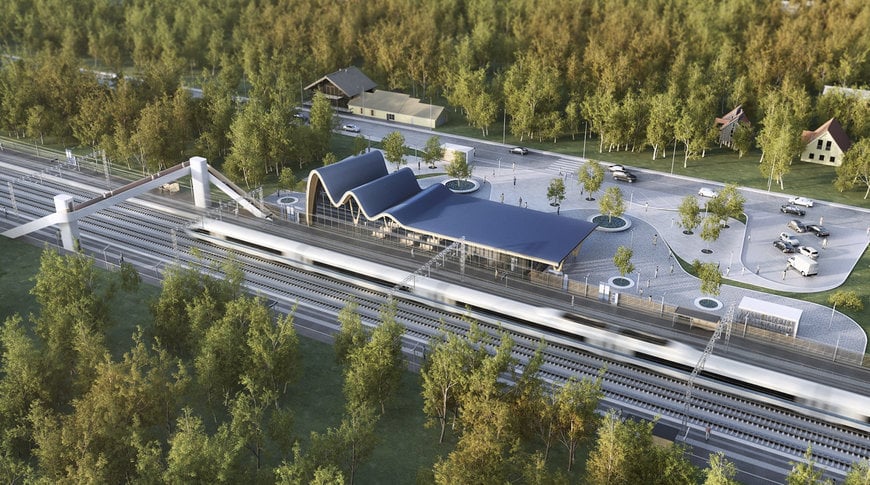Greenpeace calls for increased investment in Europe's rail infrastructure, supports Rail Baltica in recent study
Greenpeace published a study titled “Connection Failed,” which analyzed existing and potential direct rail and air transport connections between major European cities.

It was emphasized in this study that rail transport significantly reduces CO2 emissions, and the European Union and national governments were urged to invest more in rail infrastructure, referring to Rail Baltica as an example of a new connection addressing global environmental challenges.
Greenpeace analyzed 990 routes between 45 major European cities, comparing direct train connections to direct flight options. The study revealed only 12% (114 routes) are connected by train, while 69% have direct flights, offering air travelers six times more direct connections. This disparity influences the choice between flying and train travel, despite planes producing nearly five times more greenhouse gases (GHG) than trains.
Consequently, Greenpeace concluded that "European cities are still much better connected by air than by rail, which encourages people to fly instead of taking trains, despite aviation’s greater impact on the climate." It is estimated by Greenpeace that the three Baltic countries Estonia, Latvia and Lithuania are yet to be better connected with other countries, and that the capital of Estonia Tallinn is not connected by direct train with any other city analyzed in the study. To bridge this gap and offer more diverse, faster and environmentally friendly travel options across Europe, new railway infrastructure projects such as Rail Baltica are crucial according to the study.
Herwig Schuster, transport campaigner for Greenpeace Central and Eastern Europe, put Rail Baltica on a par with other major European infrastructure projects, such as the Brenner Tunnel in Austria, which connects Germany and Italy, and the Fehmarnbelt tunnel between Denmark and Germany. According to Herwig Schuster, considering the state of the Baltic rail system and the 1520 mm track gauge, Rail Baltica is a decent solution for the Baltic States to address the issues of the connectivity of this region.
“It is not only important to invest in major new projects, but also to maintain and upgrade the railway lines that serve the whole country and the regions. If people do not have access to the country’s main railway stations by public transport, many of them will choose to drive instead of taking the train, because their dependence on cars will remain,” he said.
“By developing Rail Baltica, the Baltic States are contributing to leadership at European level. The developed Western world is investing in railway construction, electrification of networks, and launching new development projects. Trends show that attention to this mode of transport is growing and that in the future rail transport will become even more important,” said Vytis Žalimas, CEO at LTG Infra, the company implementing Rail Baltica in Lithuania.
Rail Baltica emerges as a crucial project for enhancing European connectivity while addressing environmental concerns
Expected to serve for at least the next 100 years, Rail Baltica's role in mitigating climate change effects in the region is particularly significant. It is expected to play a key role in supporting energy security and accelerating the transition to renewable energy sources, in alignment with the European Union’s goal to reach net zero 2050.
“Rail Baltica’s commitment to being powered by renewable energy sources is expected to stimulate local investments in renewable technologies. This not only aligns with environmental objectives but also sets the stage for increased utilization of renewables in the energy mix, ensuring a more sustainable and secure energy future,” said Kitija Gruškevica, Chief ESG Officer and Member of the Management Board of RB Rail AS, Rail Baltica joint venture.
Rail Baltica is projected to reduce CO2 emissions by over 150,000 tCO2e annually by 2030, and more than 400,000 tCO2e per year by 2050. By promoting a shift from air to rail travel, it is expected to lower the net cost of greenhouse gas emissions by 2.3 to 3.1 billion euros and reduce fossil fuel consumption by 1.5% to 3.3% compared to average consumption between 2010 and 2021.
"When developing a greenfield infrastructure intended to meet societal needs for the next 100 years, adapting to climate change is essential. This approach not only ensures the infrastructure’s resilience and protects investments but also improves public safety, complies with regulations, and supports environmental sustainability. Rail Baltica has integrated climate considerations into every stage of the project’s life cycle, starting from the initial planning and design phases," added Gruškevica.
www.railbaltica.com

